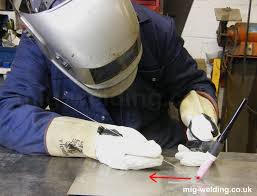- General
- 16.09.2014
- TIG welder, TIG welding process, TIG welding techniques
TIG Welding Techniques For The Best Welds
If you are learning TIG welding techniques or are just trying to be a TIG welder, the last thing that should come up to speed is the hand feeding the rod. In kindergarten, we all learned how to hold a big crayon and this is not too different from holding a TIG torch. If the hand that feeds the filler rod is a bit of a slow learner, a really thin glove helps. If you’re having problems feeling the wire, try mechanical gloves or woven cotton gloves. Below are more techniques and tips to help you out.
TIG Welding Techniques
Choose the Right-Size TIG Welding Rod
 For sheet metal up to 1/8-inch thick, do not use a welding rod bigger than the thickness of the metal you’re welding. The amperage is low and the weld puddle needs to be small to prevent blowing a hole. When you dip the rod into the puddle, the rod sucks the heat from the puddle, making it hard to maintain a consistent size bead. It is best that beginners should not practice with thin metal.
For sheet metal up to 1/8-inch thick, do not use a welding rod bigger than the thickness of the metal you’re welding. The amperage is low and the weld puddle needs to be small to prevent blowing a hole. When you dip the rod into the puddle, the rod sucks the heat from the puddle, making it hard to maintain a consistent size bead. It is best that beginners should not practice with thin metal.
TIG Torch Handle Should be 10 Degrees or Less
Ideally, the torch angle should only measure around 10 degrees or less. If you have too much torch angle, the heat will be deflected and the rod will melt even before you get into the puddle. This will cause the rod to ball up and blog into the puddle. You want to slip the filler rod into the puddle so you get a consistent bead. Exceptions to this include when you’re using a lay wire technique and are leaning the torch back while you walk the cup.
Never Let a Ball Form at the Rod End
If this happens, you are doing something wrong. It might be because, you are looking an arc that’s too long, too much torch angle, bad filler rod angle, not enough amperage or a combination of these things. The most common of these among newbies are using too much torch angle and too long an arc. A long arc means heat is not concentrated and you get this big heated arc plume like you would get with a gas welding torch.
TIG Welding Process
Thoriated Tungsten Electrodes are Radioactive
Many people say 2% thoriated tungsten electrodes are mildly radioactive, but 2% lanthanated electrodes are just as good as 2% thoriated. So if you are scared if thoriated tungsten but you are even more scared of crappy electrodes that don’t work as well, use 2% lanthanated (they are colored blue). Take note that the blue ones are not brittle like 2% thoriated electrodes. Also, they splinter if you try to break them or snip with dykes.
Use the Smallest Tungsten for the Job
Use the smallest tungsten within reason. Another way of saying this is to not just use 1/8-inch electrodes for everything. There are jobs where this small electrode is great. But if you are welding on the edge of a 0.3-inch turbine blade, a 0.4-inch electrode should be good enough to handle the 15 amps and give much better starts compared to a 1/16-inch electrode.
Get A Certified TIG Welder
While you can very well do MIG welding or TIG welding process on your own, perhaps it would be a better idea to pass on complicated weld jobs over to a person or a company that’s more experienced. Contact a certified TIG welder so you can get started.

 You MUST Ask BEFORE Hiring a Welding Company – So You Can Avoid Wasting Your Time AND Hard-Earned Dollars”
You MUST Ask BEFORE Hiring a Welding Company – So You Can Avoid Wasting Your Time AND Hard-Earned Dollars” 
Keep in Touch